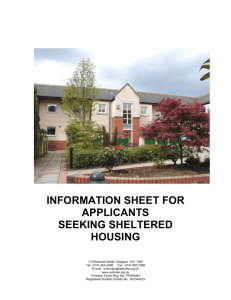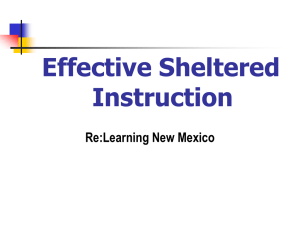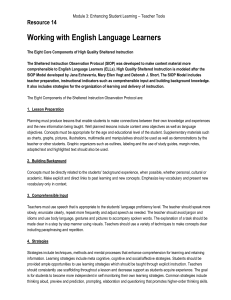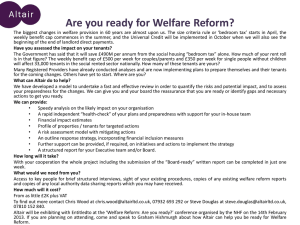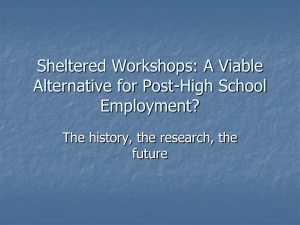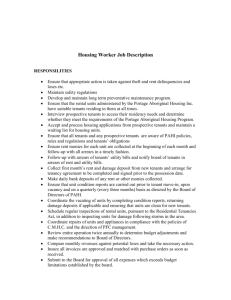Clúid-seminar-presentation-Siobhán-Fox
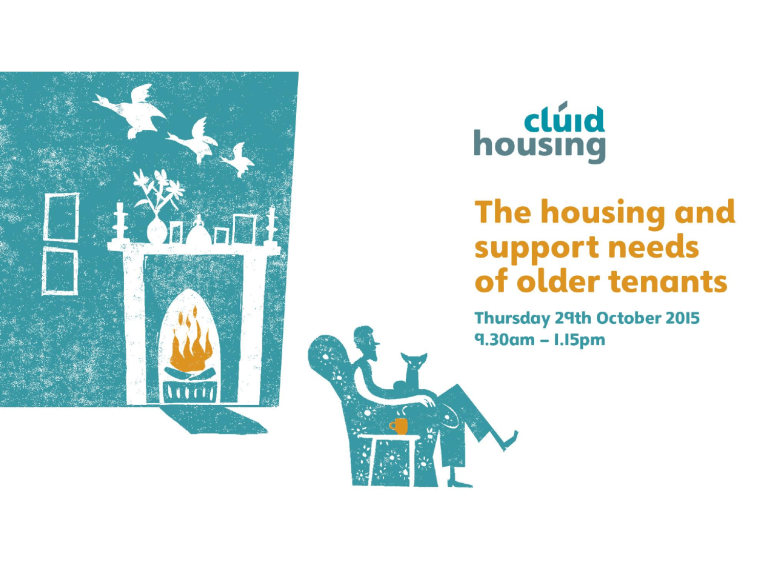
Key findings of ‘A Home
for Life: the housing and support needs of Clúid’s older tenants’
Dr Siobhán Fox
Centre for Gerontology and Rehabilitation
University College Cork
Outline of Presentation
1.
Introduction and Literature Review
2.
Results of Study 1 – Surveys
3.
Results of Study 2 – Focus-groups
4.
Summary of Recommendations
Background to the Report
• The report is the culmination of a research project funded by the ‘Adrian Norridge Research Bursary’ and conducted between April and August 2015
• Primary Aim:
• to investigate the housing and support needs of Clúid Housing’s older tenants, aged 60 years and over, who are living in mainstream or sheltered scheme accommodation.
• Three complementary data collection strategies:
• Literature review
• Surveys
• Focus-groups
Irish Demographics
• Ireland is experiencing an unprecedented ageing of the population
• The number of people aged 65 years and over is projected to increase from the 2011 level of 532,000 to between 850,000 and
860,700 by 2026, and close to 1.4 million by 2046
• This presents significant health, social and economic challenges for policy and planning.
Why is this important for
Clúid Housing?
• The house we live in and where we live can have a major impact on our physical and mental health (CARDI, 2013)
• this is particularly true for groups of people who tend to spend more time in the home, including older adults
• The standard and suitability of older people’s accommodation is therefore vital to their quality-of-life and a key factor in their capacity to take care of themselves or to be cared for at home should they become dependent
• Older people on social housing waiting lists are at greater risk of poor health and can have poorer economic and social well-being than those in the general population
Irish Policy
• Government of Ireland
• Energy efficiency grants, housing repair grants, and housing adaptations for those with disabilities.
• The National Positive Ageing Strategy for the Republic of
Ireland (May 2013)
• Objective 3.2 is to; “facilitate older people to live in wellmaintained, affordable, safe and secure homes, which are suitable to their physical and social needs”.
International Policy
• The Madrid Report of the United Nations (2002)
• covers a wide range of issues and levels, from housing to community to globalisation, that relate to healthy ageing.
• The World Health Organization’s (WHO) ‘Age-Friendly Cities
Initiative’ (2007)
1.
Outdoor Public Spaces and Public
Buildings;
2.
Transport;
3.
Health services and Community
Support;
4.
Information and Communication;
5.
Respect and social inclusion including safety;
6.
Housing: (explores preferred living arrangements and satisfaction with current living arrangements);
7.
Social Participation;
8.
Civic Participation and employment.
Ageing-in-Place
• Ageing-in-Place can be defined as “remaining living in the community, with some level of independence, rather than in residential care” (Davey, Nana, de Joux, & Arcus, 2004)
• In Ireland the HSE provides community-based services, and home care packages
Other Key Research Issues
• Physical condition of the house
• 25% of nursing home residents might be able to age-in-place in the community if adapted homes are provided (De Klerk, 2004)
• Fuel poverty
• Associated with increased cardiovascular and respiratory morbidity and mortality
• Falls
• 62% of older people who had minor home adaptations (e.g. grab rails or hand rails) felt safer in their home and 77% felt that it had a positive impact on their health (Heywood, 2001).
• Loneliness
• Associated with adverse physical and mental health problems
Other Key Issues
• Dementia friendly design
• Affects 48,000 older Irish people
• The key principles in the Centre for Excellence in Universal
Design’s report on housing for dementia (2015) are:
• Integrated into the neighbourhood;
• Easy to approach, enter and move about in;
• Easy to understand, use and manage;
• Flexible, safe, cost effective and adaptable over time.
• Assistive technologies may help also
Sheltered housing
• Ageing in place is not always possible or preferred
• Clúid defines sheltered housing as
• “accommodation for older or disabled people consisting of independent, private self-contained homes which are supported by an on-site Scheme Manager and a 24-hour emergency call system. Some sheltered housing schemes include communal spaces such a lounge / community hall, laundry room and gardens.”
Low support group housing
Sheltered housing
Very sheltered housing
Institutional care
Sheltered housing
• Sheltered housing is seen as a first choice alternative for people who can no longer live at home
• Increasing attention in Ireland, e.g. Towards 2016 report
• Evaluation
• In a UK review, most tenants were very happy with sheltered housing (Croucher et al., 2008).
• In Scotland, most tenants report a good quality-of-life, and one year after moving into the schemes most enjoyed a good social life (Netten et al., 2011).
• “better outcomes and similar or lower costs indicate that extra care housing appears to be a cost-effective alternative for people with the
same characteristics who currently move into residential care.”
Survey
Survey Methods
• Development
• Two versions: Mainstream and Sheltered housing tenants
• Developed based on literature review and face validity determined by expert advisory group
• Piloted on 10 older people
• Distribution
• Surveys were sent to all tenants in sheltered housing (n=415);
• And to two-thirds of tenants in mainstream housing (n=413)
• Participants were given the option of completing the survey over the phone
• Analysis
• Data was analysed using SPSS v.20; Valid percentages reported
Survey Results
• Response rate
• Mainstream = 44% (182/413)
• Sheltered = 48% (172/415)
• Demographics
• Tenants in sheltered housing were older than mainstream tenants
• Tenants in sheltered housing were more likely to be single or widowed, and to be living alone
• Tenants in mainstream housing found it more difficult to ‘make ends meet’
Home and Support needs
• Participants were overall satisfied with their home
• 58% of mainstream and 70% of sheltered tenants were ‘very happy’
• The physical design of homes was usually appropriate to needs
• Meets needs ‘very well’ for 48% of mainstream and 60% of sheltered tenants
• Outdoor space was available to most tenants
• However less in sheltered (69%) than mainstream (84%)
• ‘I feel locked in at times. [I am] not able to step outside. [I have] no garden and [am an] outdoor person’.
Adaptations
Mainstream
• Bathroom aids (18% need now; 35% may need in the future)
• Warden call (13% need now;
39% may need in the future)
• Front door spyhole and
keychain (31% need now;
18% may need in the future)
• Intercom (22% need now;
22% may need in the future)
Sheltered
• Bathroom aids (14% need now; 20% may need in the future)
• Adequate storage for walking
aids, wheelchair, etc. (7% need now; 25% may need in the future)
• Front door spyhole and
keychain (14% need now;
14% may need in the future)
Health and Support needs
• Health
• 59% in mainstream and 39% in sheltered had, or lived with someone who had, an illness or disability
• Mobility problems were also common in both groups
• Those in sheltered accommodation reported better health,
however they availed of more health services in the past year,
• and few people in mainstream housing felt that they needed extra help
• Fuel poverty affected about 1 in 4 tenants across schemes
• Most common reason was cost of heating
• “Storage heaters [are] not affordable to me so I never use any form of heat during the winter. I tend to put on more clothing and to go to bed very early in the death of winter”
The neighbourhood
• Sheltered housing tenants rated their neighbourhoods as more quiet and safer than those in mainstream
• This may account for higher levels of satisfaction
• More people were living on their own in sheltered accommodation, however:
• Sheltered tenants had more social contact,
• And were more likely to engage in social activities and to feel a part of their community than mainstream tenants
Looking to the future
40
%
30
20
10
0
70
I am confident that I will get the supports I need to stay living in my own home as I get older
60 57
50
41
33 33
19
5
7
4
1 1
40
%
30
20
Mainstream
10
Sheltered
0
70
My home could be easily adapted to my needs as I grow older
60
58
50 47
34
30
10
8
6
2 3 3
Looking to the future
20
%
15
35
I worry about having to move from my home into accommodation such as a nursing home
33
30
29
25
26
25
22 21
17
20
10
40
Mainstream
% 30
20
Sheltered
60
I am confident that I know all of the options available to me with regards to my housing needs as I get older
50
50
37
26
28
25
14
5
4 4
10 6
4
6
4
0
0
Moving
• Most respondents in mainstream housing would prefer to stay in their current home than move (65%),
• 19% were equivocal, and 16% would like to move
• Those who wanted to move would prefer:
• other Clúid social housing (n=30), Clúid sheltered housing (n=10), or a nursing home (n=2).
• More tenants in sheltered housing would prefer to stay living in their current home (76%)
Sheltered housing
• Tenants who moved to sheltered housing were overall satisfied (71%
‘completely satisfied’ and 20% ‘somewhat satisfied’)
Advantages Disadvantages
Independent living
Safe and secure
24 hour emergency call system
Near facilities/services that I need
Someone on hand if I need help
Communal areas and facilities
Improved social contact
-…
Outings and organised activities
171 Service charge is expensive
138
135
122
170
158
156
153
Can’t keep pets
Miss previous home
Took a long time to readjust
I don’t have the same level of social contact …
Less independence than previous home
I feel isolated even though I live near to others
House is too small 4
10
13
13
18
23
47
57
Technology
• Respondents from both schemes were equally likely to own a computer, laptop or tablet and have access to broadband.
• However, more in mainstream than sheltered housing would consider using technology for safety and security (77% vs.
56%) and health monitoring (70% vs. 53%).
• This suggests that assistive technologies may be more suitable for supporting older people in their own home in mainstream housing while other supports such as an on-site warden and alarms are preferential for those in sheltered accommodation.
Focus-Groups
Methods 2. Focus Groups
• Demographics
• 31 tenants participated in 6 focus groups
• 52% were female; Average age was 72 years (range 60-96 years)
• Methods
• Focus groups were conducted in private rooms,
• Were audio-recorded and transcribed, with permission,
• And analysed using NViVo software and Content Analysis
Themes – Mainstream Housing
• Preferred place to live
• The majority of tenants were happy with their home; many had moved from poor standard houses or sometimes homelessness
• People didn’t know a lot about their housing options as they get older
• Widespread ‘fear’ of nursing homes
• Most were unfamiliar with the term ‘sheltered housing’; some had negative perceptions
• This helps to clarify the survey finding of high support need, though an unwillingness to move, among mainstream tenants
Themes – Mainstream Housing
• Ageing-in-place and adaptations
• “I suppose one of the things that would be – well it’s certainly on my
mind, and it would be the older I get – is independent living.”
• Participants wanted adaptations to have “more confidence in
life”; bathroom adaptations were considered vital
• “Participant 1: It’s my sister’s just come over, anytime I want to have a shower, I have to have someone there, you know, because I’m afraid of my life I will slip.
Participant 2: It is, they’re very dangerous.”
• Other adaptations included hand rails and stair lifts.
• Adaptations were expensive and there was confusion about obtaining grants, meaning some did not access them
Themes – Mainstream Housing
• Heating
• Fuel poverty affected some of the participants in these focus groups. The price of fuel was the primary factor
• “[I] couldn’t afford to have the heat that we had before and I had to get a stove because it ended up that at about 8 o’clock at night that it just got so cold that I just had to go to bed. And I went to bed so many nights just to keep warm.”
• Safety and security
• Most participants worried about their safety and security
• Participants worried about falling or having an accident in the home.
• The threat of crime was also a concern; automatic gates, fob keys, security cameras valued.
Themes – Mainstream Housing
• Social connectedness
• A key issue identified as affecting older people was loneliness.
Homes which were integrated in the community provided better quality-of-life
• Neighbours were an important social support
• “My personal concern would be, I have health problems and as I’m getting older my own family are quite a bit away from me.”
• “The neighbours are absolutely fabulous. The younger ones are, they really look after us, you know.”
• Information needs
• Many expressed the view that older people needed to stay informed of their rights and options as they age.
• Clúid should have a role in communicating this information.
Themes – Sheltered Housing
• Experience of moving into sheltered housing
• The majority were very happy following the move:
• “the difference between Clúid’s housing and private housing is like a mini and a Rolls Royce. That’s the difference. And that’s the reason why I’m very satisfied with Clúid housing. I think it’s excellent. The accommodation, the heating, the layout and the gardens are tremendous and I’m delighted to be in here.”
• Confusion about the process of social housing waiting lists, causing stress
• Most lacked information about their housing options, including sheltered housing
Themes – Advantages of
Sheltered Housing
• Quality-of-Life
• Tenants reported improved QOL, with sheltered housing benefitting their mental and physical health
• “We’re living longer here.”
• Tenants felt that they had more support living in sheltered accommodations, from both on-site and off-site staff
• “There’s a caring kind of an attitude with Clúid and I like that.”
Themes – Advantages (contd.)
• Physical home and facilities
• Tenants viewed their accommodation as their ‘home’, this was closely linked with their ability to personally decorate and make changes in their homes.
• Having key facilities on-site promoted independence
• “We’re lucky, like, there’s a touch button for the heating and hot water, there’s a laundry over there and dryer. I mean, everything is there. All you need is food.”
Themes – Advantages (contd.)
• Social and Community
• A key advantage of sheltered housing discussed by tenants in all of the focus groups was the increased company and social contact
• Many spoke of the community in sheltered housing as a
‘surrogate family’
• “We’ve got a little family here, and we look out for each other.”
• Safety and security
• Neighbours looked out for each other, and would worry about each other’s safety if someone was not seen for a period of time.
• Other key advantage were alarms in the home, security cameras and gates, and the on-site managers
Themes - Recommendations to
Improve Sheltered Housing
• Built environment
• Small changes to the built environment can improve sense of safety and self-determination, e.g. windows which open easily; easy to reach shelves, presses, wall sockets; eye level ovens.
• Again, bathroom adaptations are of paramount importance
• “The most important part of the apartments as far as I’m concerned for the old person is the bathroom. That’s where an old person is the most vulnerable.”
• Timeliness of adaptations is critical to support ageing-in-place
Themes – Recommendations
(contd.)
• Access and Transport links
• Easy access to local facilities and services is critical to maintaining overall QOL and engagement
• Pets
• “I think this is of paramount importance for old people. An animal is a great thing for an old person, particularly if they are by themselves. It’s therapeutic, it’s....well, first, it relieves loneliness, secondly, it’s responsibility, and finally it’s something to worry about. So it takes away thinking about themselves and what they’ve got, and what they may not have and what the future may be.”
Themes – Recommendations
(contd.)
• Security
• Tenants most appreciated the scheme managers, and would like an increased presence including at weekends
• While security was a concern to most tenants, few serious incidents were reported. Tenants, however, were very much heightened to the threat of crime
• “Today now there’s a lot of crime. We have to be protected”
• Distinction from residential care
• Some tenants wanted a nurse to call around once a week, others disliked this associating it with residential settings
• Opt-out important to distinguish from residential care
Recommendations
Recommendations
1.
Include the tenants in the design process. Tenants value a participatory approach, where they can contribute to decisions that affect their lives.
2.
Plan appropriate built environments. Well-designed homes which allow for multiple uses as needs differ or change over time can facilitate ‘ageing-in-place’, maintaining older people’s independence and overall quality-of-life.
3.
Follow principles of ‘universal design’. Good housing design should enhance the lives of all residents, regardless of age or ability. Designs should allow for multiple uses as individuals’ needs differ or change over time.
Recommendations
4.
Locate schemes near services / facilities. Housing developments should be suitably located near to amenities to help older people maintain a suitable level of activity in their community.
5.
Design flexible housing options. Planning for future housing developments should include a range of different house layout options, to allow tenants to choose a home most suitable to their personal lifestyle / support needs.
6.
Provide suitable outdoor space. Safe outdoor space is very important to older people, as a space for hobbies, social contact, and to facilitate the health benefits of being outdoors.
Recommendations
7.
Provide / facilitate adaptations as needed. Home adaptations are critical to facilitate ageing in place. Some older people find it difficult to make these adaptations, and should be guided in the process of accessing grants, etc.
8.
Allow pets. Pet ownership in older people was important, and has significant health and social benefits, therefore pets should be allowed wherever possible.
9.
Continue to combat fuel poverty. Many older people experience fuel poverty, which has a major detrimental effect on health. Older heating systems should be replaced, and information should be provided to facilitate people accessing the relevant grants.
Recommendations
10.
Maintain safety and security. Many older people feel vulnerable, irrespective of the actual incidence of crime.
Therefore increased security features are important for both safety and peace of mind.
11.
Invest in assistive technologies when needed. Assistive technologies may be useful for some older people, but these should supplement and not replace human assistance.
12.
Maintain affordable rents and charges. Many older people living in social housing find it difficult to make ends meet, causing anxiety and related problems such as fuel poverty.
Service charges should be maintained at affordable levels.
Recommendations
13.
Provide relevant information. Older people sometimes lack information about the alternative housing and support options available to them; providing information will facilitate older tenants accessing the services they need.
14.
Provide relevant social supports. Older people in social housing appreciate organised social activities. These foster further informal relationships which provide social support and combat loneliness. Staff should also be trained in supporting the needs of older tenants.
15.
Provide opportunities for engagement in education / courses
/ activities. Older people also appreciate opportunities for
‘life-long learning’ and community engagement.
Recommendations
16.
Support tenants in accessing relevant external services.
Older people may find it difficult accessing the external supports and services they require. Clúid may be able to facilitate access to these supports by putting their own organisational relationships in place.
17.
Sheltered housing. Older people living in sheltered housing are very satisfied with their homes, and highly rate the adapted buildings, increased security and social support.
People living in mainstream housing lack awareness of sheltered housing. Therefore this housing model should continue to be developed and advertised for people with appropriate support needs.
Acknowledgements
• All of the Clúid tenants who took part in the surveys and focus groups
• Clúid staff
• Mr Simon Brooke
• Mr Mick Concannon
• Ms Rachel Lartey
• Mr Michael O’Sullivan
• All of the scheme managers who facilitated the survey and focus group studies
• UCC group
• Ms Lorna Kenney, research assistant
• Dr Suzanne Timmons
• Dr Mary-Rose Day
• Mr Joe Finnerty
• Dr Cathal O’Connell

